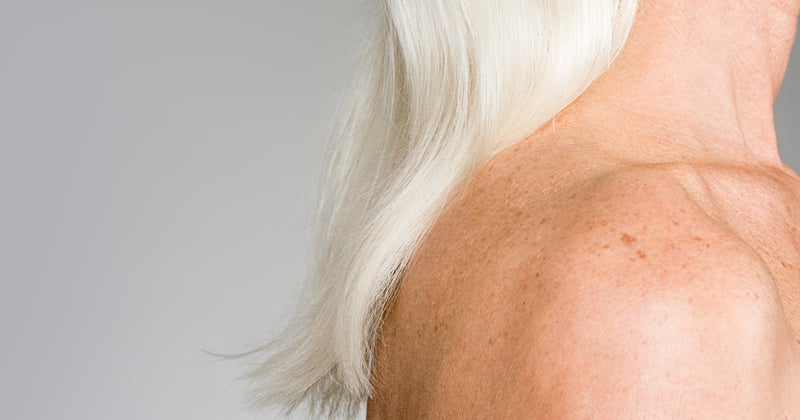

Age Spot
What Are Age Spots?
Age spots are small, flat dark areas on your skin that can vary in size. They usually appear on parts of your body that are more exposed to the sun, such as your face, shoulders, hands, and arms. Age spots are also called sunspots or liver spots, although they have nothing to do with your liver. (The sun, of course, is another story.)
Who Gets Age Spots?
Age spots are most common in adults over the age of 50. Younger people can also get them, especially if they spend too much time in the sun.
Many age spot risk factors aren’t related to age at all. For instance, you’re more likely to get age spots if you:
• Have a fair or light complexion
• Have a history of severe sunburns
• Use indoor tanning beds
What Causes Age Spots?
When ultraviolet (UV) light hits your skin, it speeds up your body’s production of melanin – the substance that gives your skin its pigment. On skin with years of sun exposure, age spots can appear when melanin is produced in high concentrations or clumped together.
Some people also develop age spots after certain medical treatments, such as radiation therapy.
How Do I Know if I Have Age Spots? Are There Symptoms?
Age spots sometimes look like cancerous growths, but they are not harmful. They are simply the skin’s attempt to protect itself from further sun damage. Most age spots:
• Range from tan to dark brown in color
• Range from the size of a freckle to about ½ inch across
• Can group together, making them more noticeable
When It’s Not an Age Spot
It’s best to have any new skin changes – including age spots – evaluated by a dermatologist. If you have a spot that’s black, growing in size, bleeds, or has an irregular border, visit us immediately. These changes could be signs of melanoma, a serious form of skin cancer.
Why Consider Age Spot Removal?
Unlike freckles, age spots don’t fade naturally. Many people have their age spots lightened or removed for cosmetic reasons.
What Are the Best Treatments for Age Spots?
Most treatments for age spots fall into two categories: creams and lotions or procedures.
Creams and lotions cost less but take longer, sometimes weeks or even months. Procedures tend to work faster, although they cost more and have a higher risk of side effects. Your Forefront dermatologist can help you decide which type of age spot treatment to try.
Creams and Lotions
There’s no shortage of over-the-counter products on the market that claim to fade age spots. If you’d like to use a cream or lotion to treat your age spots, the American Academy of Dermatology recommends seeing a board-certified dermatologist first.
Your Forefront dermatologist can examine your skin and confirm that your age spots are actually age spots, not skin cancer or any other condition. Next, we’ll determine which prescription-strength cream or lotion is the best choice for you, such as corticosteroids or retinoids.
Procedures
Your options include:
Cryosurgery – A dermatologist freezes the age spots and your skin develops a more even tone as it heals. After treatment, you may experience temporary pain, blistering, redness, or swelling.
Chemical peel – The top layer of your skin is safely removed by a chemical solution. While cryosurgery has slightly better results, skin tends to heal faster after a chemical peel.
Microdermabrasion – This procedure smooths away age spots and can be quite effective, especially after a chemical peel. Research shows that age spots disappear in about 40% of microdermabrasion patients. You may have mild inflammation for a few hours afterward.
Laser treatment – Lasers can destroy melanin-producing cells or safely remove the top layer of your skin. Many people only need one or two sessions to get rid of age spots. Side effects include crusting or temporary darkening of the age spots, although they should fade quickly.
Do Age Spots Come Back After Treatment?
They can, depending on the treatment. New age spots are more likely to develop if you don’t protect your skin from UV light. Avoid the sun between 10 AM and 2 PM, wear a hat outdoors, and always use 30 SPF sunscreen or higher.
Where Can I Find Dermatologist Treatment for Age Spots?
Just because you’re older or spent years in the sun doesn’t mean your skin has to show it. Our board-certified dermatologists can help get your age spots out of the spotlight. To learn more, find a Forefront Dermatology office near you and schedule a consultation today.
Annoyed by age spots? Book a consultation with a skin specialist today
Interested in Age Spot? Request a consultation with a skin specialist today.
*Treatment options may vary at each location.Please confirm your desired treatment is offered at your preferred location when scheduling. *Age Restriction.
For patients scheduling who are under 18 years of age (19 in Alabama) please make sure you have permission from your parent or legal guardian to schedule this appointment. Your parent or legal guardian must accompany you on your initial visit and on certain subsequent visits to provide appropriate informed consent.